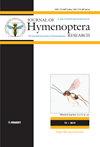牛蒡属(膜翅目、胡蜂科、马蜂亚科)分布新记录及其开花行为新资料
IF 1.4
3区 农林科学
Q2 ENTOMOLOGY
引用次数: 2
摘要
1935年,希俄斯、罗德斯、萨摩斯(希腊)、达吉斯坦(俄罗斯)、格鲁吉亚和阿塞拜疆的主要地区都有新的记录(以前的记录仅来自纳希切万自治共和国)。在Lamiaceae的六个物种中观察到了花的访视,其中四个物种首次被记录为牛蒡的饲料植物。新记录的毒藻C.A.梅。和Ziziphora taurica M.Bieb。(均为Lamiaceae)是达吉斯坦和克里米亚的主要饲料植物。雌性在牛蒡花上的行为与之前描述的变色龙属(Teucrium chamaedrys L.)和百里香属(Satureja thymbra L.)(也称为Lamiaceae)花上的不同之处在于,从花药中去除花粉和吸收花蜜在时间序列上彼此独立。这种差异显然是由齐花属的花结构引起的,特别是其更长的花冠筒。雌性也试图从鼠尾草亚种的花朵中收集花粉。tesquicola(Klokov和Pobed.)Soó,但通常没有成功,而该物种的花蜜吸收是成功的。描述了雌性从脊索花药吸收花粉和从外骨骼将花粉转移到口器的特殊形态结构。它们与亲缘关系密切的Celonites abbrevatus(Villers,1789)相似,由覆盖头部前表面的特化坚硬的“结节状”花粉收集刚毛组成,尤其是复叶和绒毛,沿着前跗骨的第一节和第二节的内表面的前缘有特别强的花粉刷毛。牛头怪的雄性沿着雌性的草料植物飞行巡逻。成功的交配要么发生在花朵上,要么发生在地面上。本文章由计算机程序翻译,如有差异,请以英文原文为准。
New distributional records of Celonites tauricus (Hymenoptera, Vespidae, Masarinae) and new data on its behaviour at flowers
New records of Celonites tauricus Kostylev, 1935 are reported from Chios, Rhodes, Samos (Greece), Dagestan (Russia), Georgia, and the main portion of Azerbaijan (previous records were made from the Nakhchivan Autonomous Republic only). Flower visits of imagines were observed at six species of Lamiaceae, four of them being recorded for the first time as forage plants of C. tauricus. The newly recorded Teucrium canum Fisch. & C.A. Mey. and Ziziphora taurica M. Bieb. (both Lamiaceae) are principal forage plants in Dagestan and the Crimea, correspondingly. The behaviour of females at flowers of Z. taurica differs from that previously described at flowers of Teucrium chamaedrys L. and Satureja thymbra L. (also Lamiaceae) in that pollen removal from the anthers and nectar uptake take place separately from each other in temporal succession. This difference is obviously caused by the flower structure of the genus Ziziphora, specifically its much longer corolla tube. Females also try to collect pollen from flowers of Salvia nemorosa subsp. tesquicola (Klokov & Pobed.) Soó but usually without success, while nectar uptake from this species is successful. The specialized morphological structures of the females for pollen-uptake from the nototribic anthers and pollen-transfer from the exoskeleton to the mouthparts are described. They are similar to those of the closely related Celonites abbreviatus (Villers, 1789), and consist of specialized stiff “knobbed” pollen-collecting setae covering the anterior surface of the head, particularly the frons and the clypeus, as well as comb-like rows of specialized, particularly strong pollen-brushing setae along the anterior margins of the inner surface of the first and the second segments of the fore tarsi. Males of C. tauricus patrol in flight along the forage plants of the females. Successful copulations occur either on flowers or on the ground.
求助全文
通过发布文献求助,成功后即可免费获取论文全文。
去求助
来源期刊
CiteScore
2.60
自引率
15.40%
发文量
68
审稿时长
>12 weeks
期刊介绍:
The Journal of Hymenoptera Research is a peer-reviewed, open-access, rapid online journal launched to accelerate research on all aspects of Hymenoptera, including biology, behavior, ecology, systematics, taxonomy, genetics, and morphology.
All published papers can be freely copied, downloaded, printed and distributed at no charge for the reader. Authors are thus encouraged to post the pdf files of published papers on their homepages or elsewhere to expedite distribution. There is no charge for color.

 求助内容:
求助内容: 应助结果提醒方式:
应助结果提醒方式:


